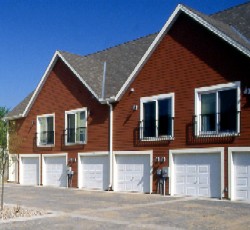| housing diversity: overview » introduction » as-of-right development » accessory dwelling units |
Accessory dwelling units are self-contained residential units that are either:
Accessory dwelling units (ADUs) - also called secondary units, granny flats, carriage houses and in-law apartments - can be an important source of low-cost rental housing for small households in many communities. They can provide an opportunity for renters to enjoy the advantages of living in established homeownership communities, including good schools and safe and quiet neighborhoods. In addition, they can provide affordable options for older adults to live in certain communities in which they have better access to amenities and transit. They can also allow people who have lost their homes to foreclosure to stay in their community as an ADU renter. ADUs may also be a boon to owners of the primary home, who collect extra income from the rental unit that can be used to help cover mortgage payments, property taxes and other costs. This extra income could prove especially helpful during economic downturns, and could help some families avoid foreclosure. |  Capitol Heights Cityhomes, St. Paul MN -- Photo courtesy of LHB, Inc. |
| Solutions in Action | Addressing community concerns:
Objections to ADUs are most often based on concerns about overcrowding,
traffic congestion and parking shortages, and a loss of neighborhood
character. However, the experience of many communities has been that
when ADUs are approved, units tend to "trickle in" rather than
overwhelm entire neighborhoods overnight. [1]
Because they are often incorporated into or next to existing homes,
ADUs have minimal impact on neighborhood density and can blend in
seamlessly with the community. Obstacles to development: Some communities prohibit ADUs entirely, while others have regulatory requirements (often unintentional) that severely limit opportunities for this development or make the development process so long and costly that private homeowners opt out. These include zoning policies that:
| |
| In 1982 the state of California passed the Second Unit Law
- legislation intended to promote the development of accessory dwelling
units by codifying a state standard for ADU approval. Under the law,
communities that had not already adopted a local ADU ordinance were
given considerable discretion in setting the terms of their own
approvals procedure and development standards. However, those that
chose not to adopt an ADU ordinance were required to approve all
proposals that met state standards. While the purpose of this legislation was to facilitate creation of additional units, implementation hit a snag when all of the jurisdictions that adopted an ordinance approved ADUs as a conditional use only. Rather than allowing development as of right, applicants had to undergo a lengthy and potentially contentious review and public hearing process that made creation of new units difficult at best. With development falling far short of expectations, in 2003 the state legislature passed Assembly Bill 1866, which amends the original law by requiring local communities to allow ADUs as of right (provided they are otherwise in compliance with the zoning code) by prohibiting local ordinances that mandate discretionary review of ADU applications. Some critics of the law point out that it only facilitates the administrative approvals process, and does not address structural conditions that localities may choose to apply, such as size and design requirements, parking regulations and other restrictive standards that can constrain development of ADUs or make them cost-prohibitive. More at Accessory Dwelling Units. 2004. Instant Advocate. Oakland, CA: Transportation and Land Use Coalition, Section 2: Is this the Right Tool for You? |
| Click
on the links below to learn more about other types of housing that can
help communities meet the needs of households with a range of
preferences and budgets: Multifamily/attached homes, which may include apartment buildings, condominiums, town homes, row houses and duplexes. "Factory-built" homes, from manufactured homes built entirely in production facilities to modular housing that is assembled on-site. Accessory dwelling units within or attached to a larger single-family home, or on the same lot. Mixed-use housing, where residential units co-exist with commercial and retail enterprises. Single-room occupancies, also called efficiency apartments and residential studio units. |
| You are currently reading: Revise zoning policies to allow development of a range of housing types "as of right" Greater housing diversity and affordability may be achieved by revising zoning policies to eliminate both direct and "back door" prohibitions and explicitly allow a range of housing types, rather than requiring a special review process or disallowing certain types of structures entirely. Other pages in this section:  Consider other innovative land use regulations that facilitate delivery of lower-cost homes Consider other innovative land use regulations that facilitate delivery of lower-cost homesLocal officials can implement an array of land use tools to create a regulatory environment that is hospitable to the development of homes affordable to working families. Click here to view other resources on zoning policies that allow housing diversity. |